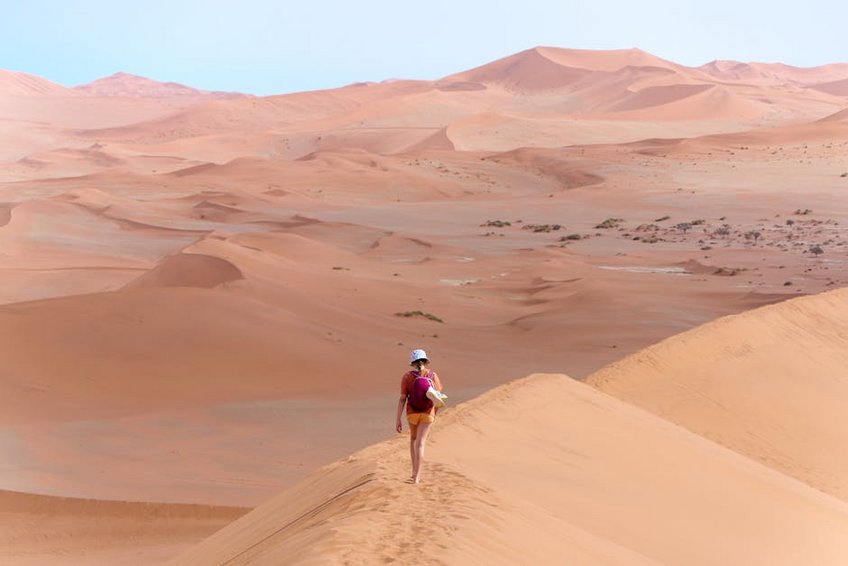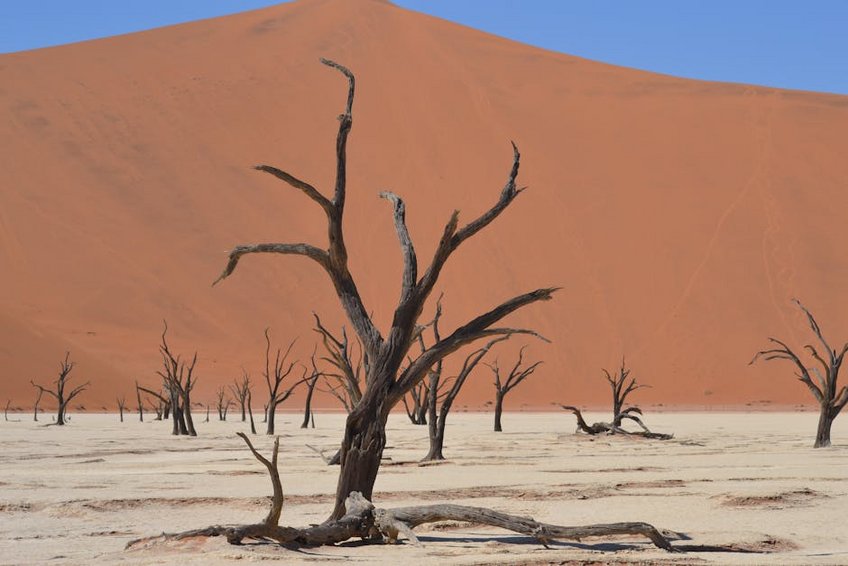Namibia Sossusvlei Dune Climbing: Conquer Africa’s Tallest Sand Dunes
Scaling the towering red dunes of Sossusvlei offers an unforgettable desert adventure in Namibia’s Namib-Naukluft National Park, where you’ll witness some of the world’s most spectacular landscapes and challenge yourself physically amid ancient sand formations. Your Namibia Sossusvlei dune climbing experience combines breathtaking panoramic views, unique photographic opportunities, and the thrill of conquering dunes that reach over 1,000 feet high against brilliant blue skies. This comprehensive guide covers essential planning tips, safety considerations, and insider knowledge to maximize your desert expedition while respecting the fragile ecosystem.
Essential Desert Information
Sossusvlei forms the dramatic heart of Namibia’s Namib Desert, featuring some of Earth’s highest sand dunes that shift constantly with wind patterns yet maintain their iconic rust-red coloration from iron oxide deposits. The area encompasses several famous dunes including Dune 45, Big Daddy, and Big Mamma, alongside the surreal white clay pan of Deadvlei with its ancient camel thorn trees preserved for centuries. Visitors access this UNESCO World Heritage site through the Sesriem Gate, which opens at sunrise for optimal climbing conditions before temperatures become extreme.
Geological History and Formation
The Namib Desert ranks among the world’s oldest at approximately 55 million years, with Sossusvlei’s dunes forming through complex processes where sand from the Orange River travels northward via ocean currents and winds. These magnificent structures continue evolving daily through wind transportation, with star-shaped dunes forming where wind directions converge and linear dunes developing in areas with consistent wind patterns. The distinctive red coloration develops through oxidation processes on iron-rich sand grains, while younger dunes appear brighter orange and older formations darken to deeper burgundy shades.
Climate and Weather Patterns
Understanding the desert climate proves crucial for safe dune exploration, with temperatures ranging from 50°F to 75°F (10°C to 24°C) in winter months and soaring to 104°F (40°C) during summer afternoons. The hyper-arid region receives less than 2 inches (50mm) of annual rainfall, primarily between February and April, though morning fog from the Atlantic Ocean provides minimal moisture for specialized desert flora and fauna. Wind patterns significantly impact your climbing experience, with calm conditions ideal for photography and stronger winds creating challenging ascent conditions but dramatic dune reshaping.
- Carry at least 1 gallon (4 liters) of water per person for morning climbs, as dehydration occurs rapidly in dry desert air even at moderate temperatures.
- Wear closed-toe shoes with grip soles specifically designed for sand traversal, as regular sneakers fill quickly and flip-flops offer inadequate foot protection from hot surfaces.
- Apply high-SPF sunscreen 30 minutes before exposure and reapply every two hours, since the desert environment intensifies UV radiation through sand reflection and clean air.
- Budget travelers spend $50-80 daily camping at Sesriem Campsite, purchasing groceries in Windhoek, and joining shared transfers while packing their own food and water for park visits.
- Mid-range visitors allocate $150-250 per day for comfortable lodges like Sossusvlei Lodge with swimming pools, guided dune tours, and rental vehicles for flexible exploration.
- Luxury experiences cost $400-600 daily at properties like Little Kulala with private guided excursions, gourmet meals, and exclusive access to conservation areas beyond standard park boundaries.
- Namibia Tourism Board Official Site
- Namibian Association of CBNRM Support Organizations
Wildlife and Ecosystem Considerations
The seemingly barren landscape supports surprising biodiversity, with oryx, springbok, and ostrich adapting through specialized water conservation methods and nocturnal activity patterns during extreme heat. Numerous insect species including fog-basking beetles and dancing white lady spiders inhabit the dunes, while smaller reptiles like shovel-snouted lizards employ fascinating thermal avoidance behaviors. Conservation efforts focus on minimizing human impact through designated pathways and restricted driving areas, ensuring this fragile environment remains preserved for future generations of adventurers and researchers.

Alt: “sossusvlei-dune-45-sunrise-climbing-adventure”
Planning Your Namibia Sossusvlei Dune Climbing Trip
Organizing your desert expedition requires careful timing and logistical preparation, with most visitors allocating three to four days to fully experience Sossusvlei’s highlights while accommodating weather variables and physical recovery needs. Your Namibia Sossusvlei dune climbing itinerary should balance early morning ascents during cooler hours with afternoon exploration of surrounding attractions like Sesriem Canyon and Elim Dune. Booking accommodations six months in advance secures preferred lodging near the park entrance, granting earlier access to dunes before day-trippers arrive from distant locations.
Best Time to Visit Sossusvlei
Visit between May and October for optimal climbing conditions, when daytime temperatures range from 68°F to 82°F (20°C to 28°C) with minimal rainfall and comfortable overnight lows around 50°F (10°C). These winter months provide the clearest skies for photography and the most manageable physical conditions for strenuous dune ascents, though early mornings begin chilly requiring layered clothing. Shoulder seasons in April and November offer fewer crowds with slightly warmer temperatures, while summer months from December to March bring extreme heat exceeding 104°F (40°C) that limits climbing to brief early morning windows.
Budget Planning and Costs
Desert adventures accommodate various spending levels through strategic planning and off-peak travel considerations.
Essential Preparation Checklist
Pack lightweight, light-colored clothing with long sleeves for sun protection, plus a warm jacket for chilly desert nights that can drop to 41°F (5°C) during winter months. Essential gear includes a headlamp for pre-dawn starts, a hydration pack or multiple water bottles, high-energy snacks, and a basic first-aid kit with blister treatment supplies. Secure necessary documentation including your passport, international driver’s license if renting a vehicle, travel insurance with emergency evacuation coverage, and printed park permits for smooth entrance processing.
Top Attractions and Activities
Sossusvlei delivers diverse experiences beyond dune climbing, with each location offering unique perspectives on this ancient desert landscape through different times of day and seasonal variations. The area’s star attractions include massive dunes reaching over 1,066 feet (325 meters), surreal pan landscapes where ancient trees stand against white clay, and fascinating geological formations revealing millions of years of natural history. Plan your days around early morning and late afternoon activities when lighting enhances photographic opportunities and temperatures remain comfortable for extended exploration.
Must-See Highlights
Dune 45 stands as the most photographed and climbed formation, rising 260 feet (80 meters) beside the access road with relatively manageable slopes perfect for sunrise ascents and panoramic valley views. Big Daddy represents the tallest dune in the Sossusvlei area at 1,066 feet (325 meters), requiring two to three hours for the round-trip climb but rewarding adventurers with breathtaking vistas over Deadvlei. The nearby Deadvlei pan features centuries-old camel thorn trees preserved in white clay against orange dune backdrops, creating one of Africa’s most iconic and photographed landscapes throughout daylight hours.
Sesriem Canyon offers fascinating geological exploration just four miles from the park entrance, where the Tsauchab River carved narrow gorges up to 98 feet (30 meters) deep over millions of years. Elim Dune provides an excellent warm-up climb near the entrance gate, standing just 131 feet (40 meters) high with 360-degree views perfect for sunset photography and acclimating to sand walking techniques. Hiddenvlei remains less visited than neighboring attractions, offering peaceful isolation and exceptional birdwatching opportunities amid smaller dunes and vegetation patches away from main tourist routes.
Hidden Gems and Local Favorites
Explore the less-visited dune fields beyond Big Daddy where you’ll encounter fascinating wildlife tracks and unique photographic compositions without competing with other visitors for space and solitude. Local guides recommend the eastern sections of Sossusvlei for spotting oryx and springbok during early mornings, when animals venture closer to the pan areas seeking moisture from occasional fog condensation. The Tsauchab River bed occasionally flows after rare rains, creating temporary pools that attract abundant birdlife and provide surreal reflection opportunities for landscape photographers visiting during these brief windows.
Photography Tips for Desert Landscapes
Capture the dunes during golden hour when low-angle light enhances texture and coloration, using a polarizing filter to reduce glare and increase saturation of the red sands against deep blue skies. Compose images incorporating leading lines like dune ridges and animal tracks, while including human figures for scale against the massive formations to emphasize their monumental proportions. Protect camera equipment from fine sand particles using plastic bags or specialized covers, and carry extra batteries since cold desert mornings can significantly reduce battery performance during extended shooting sessions.
Practical Travel Information
Reaching Sossusvlei involves flying into Windhoek’s Hosea Kutako International Airport (WDH), then driving approximately 220 miles (350km) southward on well-maintained gravel roads requiring five to six hours with scenic stops along the way. Most visitors rent 2WD vehicles for budget travel during dry season or opt for 4×4 rentals for year-round access and exploration of more remote desert areas beyond main tourist routes. Accommodations range from basic campsites to luxury desert lodges, with advanced reservations essential during peak season from June through October when properties fill months in advance.
| Accommodation Type | Features and Amenities | Price Range (USD) |
|---|---|---|
| Camping | Basic facilities, shared bathrooms, fire pits, stunning star-gazing | $15-30 per night |
| Guesthouse | Private rooms, en-suite bathrooms, breakfast included, pool access | $80-150 per night |
| Desert Lodge | Luxury amenities, guided activities, gourmet dining, spa services | $250-400 per night |
| Private Reserve | Exclusive access, personalized guides, all-inclusive packages | $500-800 per night |


